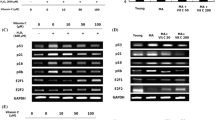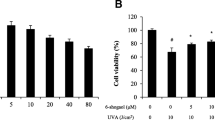Abstract
Dicarbonyls glyoxal (GO) and methylglyoxal (MGO) produced during the autoxidation of reducing sugars are a source of macromolecular damage in cells. Since an accumulation of damaged macromolecules is a universal characteristic of aging, we have tested whether GO and MGO which cause oxidative damage to proteins and other macromolecules can bring about accelerated aging in normal human skin fibroblasts in vitro. A treatment of cells with 1.0 mM GO or 400 μM MGO leads to the appearance of senescent phenotype within 3 days, as judged by the following criteria: morphological phenotype, irreversible growth arrest and G2 arrest, increased senescence-associated β-galactosidase (SABG) activity, increased H2O2 level, increased Nξ-(carboxymethyl)-lysine (CML) protein level, and altered activities of superoxide dismutase and catalase antioxidant enzymes. This experimental model of accelerated cellular aging in vitro can be useful for studies on testing the effects of various physical, chemical and biological conditions, including natural and synthetic molecules, for the modulation of aging.






Similar content being viewed by others
References
Abordo EA, Minhas HS, Thornalley PJ (1999) Accumulation of alpha-oxoaldehydes during oxidative stress: a role in cytotoxicity. Biochem Pharmacol 58:641–648. doi:10.1016/S0006-2952(99)00132-X
Adamson AW, Beardsley DI, Kim WJ, Gao Y, Baskaran R, Brown KD (2005) Methylator-induced, mismatch repair-dependent G2 arrest is activated through Chk1 and Chk2. Mol Biol Cell 16:1513–1526. doi:10.1091/mbc.E04-02-0089
Ahmed MU, Brinkmann Frye E, Degenhardt TP, Thorpe SR, Baynes JW (1997) N-epsilon-(carboxyethyl)lysine, a product of the chemical modification of proteins by methylglyoxal, increases with age in human lens proteins. Biochem J 324(Pt 2):565–570
Ben-Porath I, Weinberg RA (2004) When cells get stressed: an integrative view of cellular senescence. J Clin Invest 113:8–13
Brownlee M, Vlassara H, Cerami A (1984) Nonenzymatic glycosylation and the pathogenesis of diabetic complications. Ann Intern Med 101:527–537
Chen J, Goligorsky MS (2006) Premature senescence of endothelial cells: Methusaleh’s dilemma. Am J Physiol Heart Circ Physiol 290:1729–1739. doi:10.1152/ajpheart.01103.2005
Collado M, Serrano M (2006) The power and the promise of oncogene-induced senescence markers. Nat Rev Cancer 6:472–476. doi:10.1038/nrc1884
Cristofalo VJ, Lorenzini A, Allen RG, Torres C, Tresini M (2004) Replicative senescence: a critical review. Mech Ageing Dev 125:827–848. doi:10.1016/j.mad.2004.07.010
Dimri GP, Lee X, Basile G, Acosta M, Scott G, Roskelley C et al (1995) A biomarker that identifies senescent human cells in culture and in aging skin in vivo. Proc Natl Acad Sci USA 92:9363–9367. doi:10.1073/pnas.92.20.9363
Epel ES, Blackburn EH, Lin J, Dhabhar FS, Adler NE, Morrow JD et al (2004) Accelerated telomere shortening in response to life stress. Proc Natl Acad Sci USA 101:17312–17315. doi:10.1073/pnas.0407162101
Gorbunova V, Seluanov A, Pereira-Smith OM (2002) Expression of human telomerase (hTERT) does not prevent stress-induced senescence in normal human fibroblasts but protects the cells from stress-induced apoptosis and necrosis. J Biol Chem 277:38540–38549. doi:10.1074/jbc.M202671200
Hipkiss AR (2006) Accumulation of altered proteins and ageing: causes and effects. Exp Gerontol 41:464–473. doi:10.1016/j.exger.2006.03.004
Islam KN, Takahashi M, Higashiyama S, Myint T, Uozumi N (1995) Fragmentation of ceruloplasmin following non-enzymatic glycation reaction. J Biochem 118:1054–1060
Kasai H, Iwamoto-Tanaka N, Fukada S (1998) DNA modifications by the mutagen glyoxal: adduction to G and C, deamination of C and GC and GA cross-linking. Carcinogenesis 19:1459–1465. doi:10.1093/carcin/19.8.1459
Keller GA, Warner TG, Steimer KS, Hallewell RA (1991) Cu, Zn superoxide dismutase is a peroxisomal enzyme in human fibroblasts and hepatoma cells. Proc Natl Acad Sci USA 88:7381–7385. doi:10.1073/pnas.88.16.7381
Koito W, Araki T, Horiuchi S, Nagai R (2004) Conventional antibody against Nepsilon-(carboxymethyl)lysine (CML) shows cross-reaction to Nepsilon-(carboxyethyl)lysine (CEL): immunochemical quantification of CML with a specific antibody. J Biochem 136:831–837. doi:10.1093/jb/mvh193
Kueper T, Grune T, Prahl S, Lenz H, Welge V, Biernoth T et al (2007) Vimentin is the specific target in skin glycation structural prerequisites, functional consequences, and role in skin aging. J Biol Chem 282:23427–23436. doi:10.1074/jbc.M701586200
Kurz DJ, Decary S, Hong Y, Erusalimsky JD (2000) Senescence-associated (beta)-galactosidase reflects an increase in lysosomal mass during replicative ageing of human endothelial cells. J Cell Sci 113(Pt 20):3613–3622
Niwa Y, Iizawa O, Ishimoto K, Akamatsu H, Kanoh T (1993) Age-dependent basal level and induction capacity of copper-zinc and manganese superoxide dismutase and other scavenging enzyme activities in leukocytes from young and elderly adults. Am J Pathol 143:312–320
Rattan SI (2008a) Increased molecular damage and heterogeneity as the basis of aging. Biol Chem 389:267–272
Rattan SI (2008b) Cell senescence in vitro. In: Encyclopedia of the Life Sciences. Wiley: Chichester. doi: 10.1002/9780470015902.a0002567.pub2
Rattan SI, Sodagam L (2005) Gerontomodulatory and youth-preserving effects of zeatin on human skin fibroblasts undergoing aging in vitro. Rejuvenation Res 8:46–57. doi:10.1089/rej.2005.8.46
Reddy S, Bichler J, Wells-Knecht KJ, Thorpe SR, Baynes JW (1995) N epsilon-(carboxymethyl)lysine is a dominant advanced glycation end product (AGE) antigen in tissue proteins. Biochemistry 34:10872–10878. doi:10.1021/bi00034a021
Sejersen H, Rattan SI (2007) Glyoxal-induced premature senescence in human fibroblasts. Ann NY Acad Sci 1100:518–523. doi:10.1196/annals.1395.057
Shangari N, O’Brien PJ (2004) The cytotoxic mechanism of glyoxal involves oxidative stress. Biochem Pharmacol 68:1433–1442. doi:10.1016/j.bcp.2004.06.013
Shangari N, Bruce WR, Poon R, O’Brien PJ (2003) Toxicity of glyoxals-role of oxidative stress, metabolic detoxification and thiamine deficiency. Biochem Soc Trans 31:1390–1393
Shangari N, Chan TS, Popovic M, O’Brien PJ (2006) Glyoxal markedly compromises hepatocyte resistance to hydrogen peroxide. Biochem Pharmacol 71:1610–1618. doi:10.1016/j.bcp.2006.02.016
Teixeira HD, Schumacher RI, Meneghini R (1998) Lower intracellular hydrogen peroxide levels in cells overexpressing CuZn-superoxide dismutase. Proc Natl Acad Sci USA 95:7872–7875. doi:10.1073/pnas.95.14.7872
Toussaint O, Remacle J, Dierick JF, Pascal T, Frippiat C, Royer V et al (2002) Stress-induced premature senescence: from biomarkers to likeliness of in vivo occurrence. Biogerontology 3:13–17. doi:10.1023/A:1015226524335
Tsutsui T, Kumakura S, Yamamoto A, Kanai H, Tamura Y, Kato T et al (2002) Association of p16(INK4a) and pRb inactivation with immortalization of human cells. Carcinogenesis 23:2111–2117. doi:10.1093/carcin/23.12.2111
Watson JV, Chambers SH, Smith PJ (1987) A pragmatic approach to the analysis of DNA histograms with a definable G1 peak. Cytometry 8:1–8. doi:10.1002/cyto.990080101
Wolff SP, Dean RT (1987) Glucose autoxidation and protein modification. The potential role of ‘autoxidative glycosylation’ in diabetes. Biochem J 245:243–250
Xie L, Pandey R, Xu B, Tsaprailis G, Chen QM (2008) Genomic and proteomic profiling of oxidative stress response in human diploid fibroblasts. Biogerontology. doi:10.1007/s10522-008-9157-3
Acknowledgments
We thank Dr. Peter Kristensen for his interest and useful suggestions made during the course of these studies. Thanks to Helle Jakobsen and Gunhild Siboska for their technical assistance; to Alexander Schmitz for help in the FACS analysis; and to Cristovao Lima for performing the comet assay. The Laboratory of Cellular Ageing is supported by research grants from the Danish Medical Research Council (FSS), and EU’s Biomed Health Programme, Proteomage.
Author information
Authors and Affiliations
Corresponding author
Rights and permissions
About this article
Cite this article
Sejersen, H., Rattan, S.I.S. Dicarbonyl-induced accelerated aging in vitro in human skin fibroblasts. Biogerontology 10, 203–211 (2009). https://doi.org/10.1007/s10522-008-9172-4
Received:
Accepted:
Published:
Issue Date:
DOI: https://doi.org/10.1007/s10522-008-9172-4




